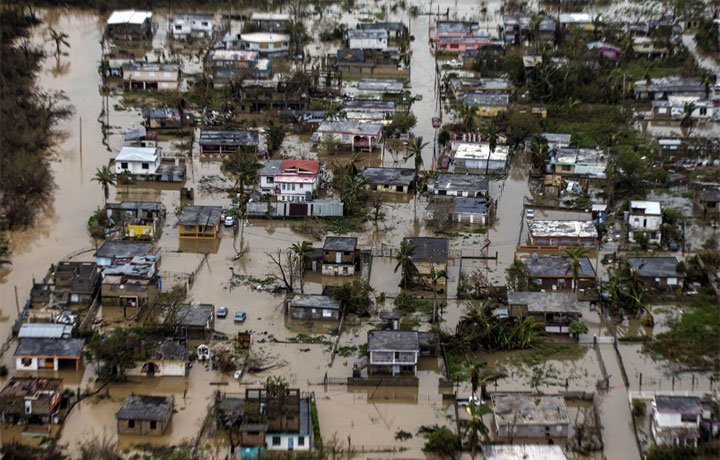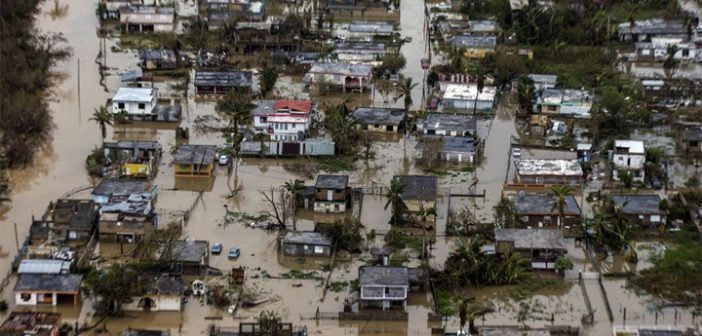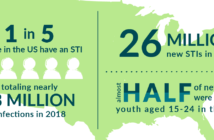
Puerto Rico is more than $74 billion in debt.
Credit: @nycgov
Puerto Rico has come a long way since the hit of Hurricane Maria. FEMA has reported a month and half after Maria, that 92 percent of cell service has been restored, 41 percent of powers was restored, and 81 percent of citizens now have access to clean water. On Dec. 8, more than two months and a half after Maria hit, 68 percent of power needed on the island was restored and only 7 percent of customers lack access to clean water, according to Bloomberg. Also, Fox News, said that 1,000 of businesses remain closed due to the conditions.
However, these efforts are clearly not sufficient enough since on Dec. 11, New York Gov. Andrew M. Cuomo and Puerto Rico Gov. Ricardo Rossello pleaded to Congress to pass a 94.4 billion dollar hurricane recovery package to help with rebuilding the island after the devastation of the storms, according to AM New York. In fact, more than 27 billion dollars of the requested funds would be aimed at reestablishing and modernizing the power structure, especially since, currently, majority of the island is still without power.
However, getting the funding may be difficult, especially since the Puerto Rico is a territory and states tend to get preferential treatment. This was something that Mr. Francis Orlando, Saint Leo University’s instructor of political science, mentioned as well.
“States over territory have certain benefits like the ability to get faster funding and relief,” said Orlando.
It was true in the case following the hurricanes. States like Florida and Texas, were able to get aid faster than Puerto Rico did. Professor of History at Saint Leo University Dr. Douglas Astolfi mentioned this as well.
“Congress passed a bill that air marks 35 billion dollars … in aid to Puerto Rico as a result of the hurricane damage but, it’s been slow if we think how quickly Congress acted to relive the people of Texas and Florida with grants; it’s now been a month and half … since the hurricane hit,” said Astolfi.
The House passed this legislation in mid-Oct. for a little over 35 billion dollars but only a fraction of the funds goes to Puerto Rican fund. “The package includes $18.7 billion for the Federal Emergency Management Agency’s (FEMA) disaster relief fund — including $4.9 billion for a disaster relief loan account — $16 billion to address national flood insurance program debt and $576.5 million for wildfire recovery efforts. It also provided $1.27 billion for disaster food assistance for Puerto Rico,” according to The Hill.
The Senate sent this relief bill to President Donald Trump on Oct. 24, which Trump signed two days later.
However, there were some in the senate, who voted against it, in particular some Republicans. Some senators, who pushed for additional funding to be in the bill were Ted Cruz and John Cornyn, as reported by Bloomberg. In fact, according to the Hill, six Republicans from Texas voted against the bill. One of the Republicans who opposed the bill was Texas Governor Greg Abbott (R). Abbot “called for his state’s congressional delegation to vote against the bill unless it included an additional $18.7 billion in funding specifically for Texas to recover from Hurricane Harvey,” as reported by the Hill.
“I am disappointed that most members of the Texas congressional delegation have agreed to go ahead and vote for this bill, from what I know at this time, when Texas needs this money,” Abbott told the Houston Chronicle. “It appears the Texas delegation will let themselves be rolled by the House of Representatives.”
Ironically, the senate already approved 15 billion dollars in hurricane relief efforts in the wake of Hurricane Harvey, only a week after the hurricane hit. This bill for 36.5 billion, which was approved more than month after Hurricane Maria hit, was the second allotment for Texas, Florida, and other southern states that were affected by hurricanes. However, the bill was the first allotment for Puerto Rico, according to LA Times. This is evident that there would seem to be quicker action for states rather than territories.
This bill also included Puerto Rico and U.S. Virgin Islands gaining access to 4.9 billion dollars in low-interest short-term Treasury loans, as reported by Bloomberg. It was reported by Bloomberg as well that as of Dec. 8 Puerto Rico hasn’t received these loans.
This delay in giving Puerto Rico access to funds seems to be fueling Puerto Rico’s governor to plead for more funding to Congress.
“We’re not asking more, we’re not asking less than other states, we’re asking the same treatment that Texas would have gotten or that Florida would have gotten, or California, or the Virgin Islands,” said Rosello, according to AM New York.
And Astolfi mentioned that we should start seeing Puerto Ricans as citizens, because they are.
“We can only hope that … we will wake up to the fact that since these our citizens we owe them the assistance that we will give our citizens in a crisis, in Florida, in Texas, our victims in fire of California,” said Astolfi.
Astolfi also mentioned that barriers that Puerto Ricans face since Puerto Rico is a territory rather than a state. He states that they don’t vote for a President, and there is no formal elected voice in Congress that can vote.
“It hurts in that they are not independent actors. Puerto Rico has to do what United States tell them to do,” said Astolfi.
Despite these negatives, there are some benefits that Puerto Rico possess from being territory. In fact, Astolfi mentioned that for a long time being a territory helped the country because they have access to American market without tariffs or other tax barriers, received aid from Federal government, and Puerto Ricans are able to move to the United States freely as they are citizens.
Clearly, not being completely autonomous has both positive and negative effects.
Nevertheless, Puerto Rico was suffering soon after the hurricane and the months to follow as the majority of the population was left without power and limited access to clean water, food, and healthcare.
In Oct., Astolfi mentioned that 70 percent of the country was without power, and how poor the condition Puerto Ricans were facing just over a month after the storm.
“The most recent report I read said that 70 percent of Puerto Rican’s still do not have power. There was an article in the New York Times either today or yesterday talking about the fact that Puerto Rico is living in nineteenth century conditions: no power, no clean running water, no reasonable health care,” said Astolfi. “It is bewildering that we have a part of the United States that has been so devastated.”
Astolfi mentioned that we seem to forget that a large part of the population lives outside of the urban area. Therefore, a large percentage of the population didn’t have access to clean water or access to hospitals.
“There is no excuse for there not being clean water in Puerto Rico. God knows tons of water was being donated and it hasn’t gotten to them,” said Astolfi. “There is no excuse for there to be a lack of hospital care for Puerto Ricans. We got it inside San Juan, the capital, because power has largely reestablished there but for the rest of the islands there is no power. So, if you’re suffering from any number of medical problems. It is easy to say ‘why don’t you go to San Juan’ but the roads are all washed out.”
In fact, a lot of the roads and other infrastructure suffered major damages, with debris covering roads and bridges collapsing. This resorted in many people, who live in rural area, not having access the cities to get resources and vice versa as many FEMA members weren’t being able to deliver aid to them.
“Obviously, FEMA has sent a lot supplies down there; the issue is once they get there how do they get to the place they need to go when there is already shortages of gas, shortage of electricity,” said Orlando.
Orlando also mentioned that the Jones Act would help as well. Trump waved the Jones Act about a month and half after the hurricane hit. This means that more goods can be shipped to Puerto Rico and shipped in speedy delivery. That is one thing that positive because there were tens of thousands of containers that got to the port of San Juan and got clothes, food, medical supplies, and fuel quickly. However, the problem that still remains is the trouble of distributing goods to parts of the country.
Despite difficulty of getting to the places they need to help, FEMA announced in mid-December that federal assistance topped 1 billion dollars, according to ABC News.
However, this doesn’t seem to be enough since the governor was requesting more funds, also because on
the same day as this, an expert of United Nations visited Puerto Rico to assess the damage on the island because officials were voicing that United States has not provide sufficient help for hurricane relief efforts, according to Fox News.
So, there is more hope for progress on the relief efforts and aid for Puerto Rico in the near future. However, the relief effort is still not addressing the enormous debt that Puerto Rico is facing.
For more information, on the 74 billion dollar debt of Puerto Rico and options they can take to recover, please see the following article: Puerto Rico Stuck in $74 Billion in Debt.





